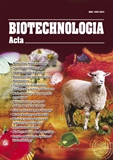ISSN 2410-7751 (Print)
ISSN 2410-776X (Online)

Biotechnologia Acta Т. 18, No. 2, 2025
P. 86-88 , Bibliography 4 , Engl.
UDC 577.21:578.1
doi: https://doi.org/10.15407/biotech18.02.086
EVALUATION OF NUCLEIC ACID EXTRACTION METHODS FOR PATHOGEN DETECTION USING PCR
D.K. Prokhorenko 1, 2, I. I. Grynyuk 1
1Igor Sikorsky Kyiv Polytechnic Institute, Kyiv, Ukraine
2“XEMA” LLC, 23 Akademika Yefremova St., Kyiv, Ukraine
This work focuses on evaluating nucleic acid extraction methods and optimizing lysis buffer components to enhance nucleic acid yield and minimize the impact of potential inhibitors on target gene amplification to improve the detection of causative pathogens and facilitate their integration into diagnostic practice.
Aim. To compare nucleic acid extraction methods from patient biological samples and to optimize lysis buffer composition to enhance nucleic acid yield.
Methods. Spectrophotometric and fluorometric methods were used to assess the efficiency and quality of nucleic acid extraction. The concentration of the obtained nucleic acids was measured using a Qubit 4 fluorometer. The quality of the extracted nucleic acids was analyzed by electrophoretic separation in agarose gel, which allowed for the assessment of their integrity and the presence of degradation. To evaluate the inhibition of target genes by extraction agents, real-time PCR was applied.
Results. Solid-phase extraction using silica-coated magnetic particles demonstrated superior performance compared to liquid-liquid extraction. Optimal lysis conditions were achieved using 2.7 M guanidinium thiocyanate with 30% isopropanol, which enhanced DNA recovery and inhibitor removal. The addition of glycogen-linear polyacrylamide improved DNA precipitation in the liquid-liquid method. Overall, the solid-phase approach showed better amplification efficiency and nucleic acid yield.
Conclusions. It was established that solid-phase extraction methods based on silica-coated magnetic carriers are optimal for isolating nucleic acids from patients’ biological samples for pathogen differentiation.
Keywords: nucleic acid extraction, pathogen identification, polymerase chain reaction, diagnostics
© Palladin Institute of Biochemistry of the National Academy of Sciences of Ukraine, 2025
Refernces
1. Singer, M., Deutschman, C.S., Seymour, C.W., Shankar-Hari, M., Annane, D., Bauer, M., Bellomo,
R., Bernard.,…, Angus, D.C. (2016). The Third International Consensus Definitions for Sepsis and
Septic Shock (Sepsis-3). JAMA, 23, 315(8), 801–810. https://doi.org/10.1001/jama.2016.0287
2. World Health Organization. Sepsis [Electronic resource] / World Health Organization. URL:
https://www.who.int/news-room/fact-sheets/detail/sepsis. (Accessed. April, 2025).
3. Lucena-Aguilar, G., Sánchez-López, A.M., Barberán-Aceituno, C., Carrillo-Ávila, J.A., López-
Guerrero, J.A., Aguilar-Quesada, R. (2016). DNA Source Selection for Downstream Applications
Based on DNA Quality Indicators Analysis. Biopreserv Biobank, 14(4), 264–270. https://doi.
org/10.1089/bio.2015.0064
4. Stellwagen, N. C. (2009). Electrophoresis of DNA in agarose gels, polyacrylamide gels and in free
solution. Electrophoresis, 30(S1). https://doi.org/10.1002/elps.200900052.

